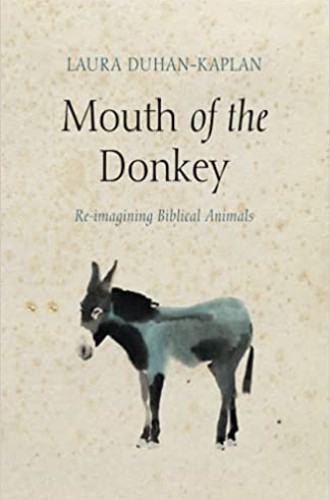Animal midrash
Jewish scholar Laura Duhan-Kaplan opens our eyes to biblical birds, insects, and mammals.
When I was in seminary, I took care of a preschooler most days of the week. She knew that I was going to school, and one day she asked me, “What are you going to be?” I asked her if she knew what a minister was. She thought hard. Then, undoubtedly recalling her board book about the nativity story, she replied, “It’s something to do with donkeys.”
Like a child who takes your face in her hands and turns your head toward the object of her gaze, Laura Duhan-Kaplan calls our attention to key animals in scripture and helps us view them through different (and often fascinating) lenses. Duhan-Kaplan, a rabbi who teaches Jewish studies at Vancouver School of Theology, opens our eyes to see many of the biblical birds, insects, and mammals we might otherwise regard as insignificant or meaningless. She uses “strictly traditional methods” to illuminate the stories of these animals, following the inquisitive, imaginative spirit of early rabbinic interpreters. Mouth of the Donkey reads like midrash.
Duhan-Kaplan’s interpretations are well documented and rooted in Jewish tradition. She describes scripture as “loaded with so much meaning that humans will never fully map it. We study in groups, learn old interpretations, craft new ones—and we still barely scratch the surface.” Describing the approach of the rabbinic interpreters, she explains that “at every opportunity, they asked a creative question. Then, they came up with an imaginative answer, grounded in the biblical text. And when you’re always engaging that deeply, the text is always relevant.”
Among the animals whose stories Duhan-Kaplan explores are sheep, donkeys, corvids (crows and ravens), snakes, eagles, locusts and grasshoppers, and “the wolf and lamb together.” Duhan-Kaplan follows the creativity of the rabbinic interpreters in asking about each animal: What does this creature call our attention to in this story?
Of all the animals Duhan-Kaplan writes about, my favorite is the donkey. Throughout the Hebrew Scriptures, donkeys contribute to what scholars call a “type scene,” which means that the animal’s presence in the story takes the reader’s thinking along a predictable trajectory. When someone in scripture mounts a donkey, the person usually doesn’t know exactly where they are going, Duhan-Kaplan notes. This is true of Abraham when he sets out for Mount Moriah with Isaac (Gen. 22); of Abigail, who prevents a massacre by riding a donkey to locate and negotiate with David (1 Sam. 25); and of the unnamed woman from Shunem, who rides her donkey to find Elisha when her son dies (2 Kings 4). Duhan-Kaplan writes that the type scene set up by biblical donkeys is clear: “If you ride your donkey, who may be following God’s directions, you find your way.”
She also mentions the Zechariah 9:9 passage which is tied to the New Testament story of Palm Sunday. Here the donkey represents a different kind of kingship than the horses and chariots that the political rulers are riding into town. But it also evokes a spiritual journey, Duhan-Kaplan notes. Riding the donkey is “like a metaphor for developing spiritual perception. You saddle up, go on an inner journey, and return with deepened insight.”
Donkeys are associated with “hope, divine guidance, and messianic time” in both Jewish and Christian traditions. “Humanity can stand to take direction from the donkey’s unique blend of stability, loyalty, and intuition,” Duhan-Kaplan writes. The donkey takes its rider safely and successfully to where the rider needs to go. “Riding the donkey” on Palm Sunday is a journey for Christians just as it was for Jesus. This journey calls us to go deeper into hope in the midst of suffering, betrayal, and death and, without knowing exactly how we’ll get there, to go deeper toward Easter resurrection.
Some of Duhan-Kaplan’s explorations of biblical creatures offer insights into the ethical issues of our time. The book’s final chapter, for instance, is on the peaceable kingdom found in Isaiah 11. Seeking to deepen our understanding of the cow and bear, Duhan-Kaplan describes them as grieving mothers:
In agricultural life, a cow is often a bereaved mother, whose children are sold or slaughtered. And bears in the Tanakh are usually mother bears, savagely seeking their missing cubs. In Isaiah’s vision, these two grieving mothers bond. They set aside their painful histories and, together, they seek a new way of living. They raise their children, different as they are, side by side, as friends.
In this interpretation, Duhan-Kaplan finds hope that parents can teach their children peaceful ways of coexisting with others who are different from themselves.
Reading this book and remembering my young friend’s definition of a minister all those years ago, I went to Luke 2 and Matthew 1–2 to see what they say about donkeys. I found that there are no donkeys (or camels for that matter) mentioned in either text. How did they get so ensconced in our nativity narratives? A little more research revealed that they entered the story because of our own Christian midrash, if you will. They appear in extracanonical texts from the second century: the Gospel of James and the Infancy Gospel of Matthew.
Mouth of the Donkey is a little book that inspires creative biblical reading, expands imagination, and deepens focus. Duhan-Kaplan provides all of us with resources to “ride the donkey” on a new spiritual journey.





